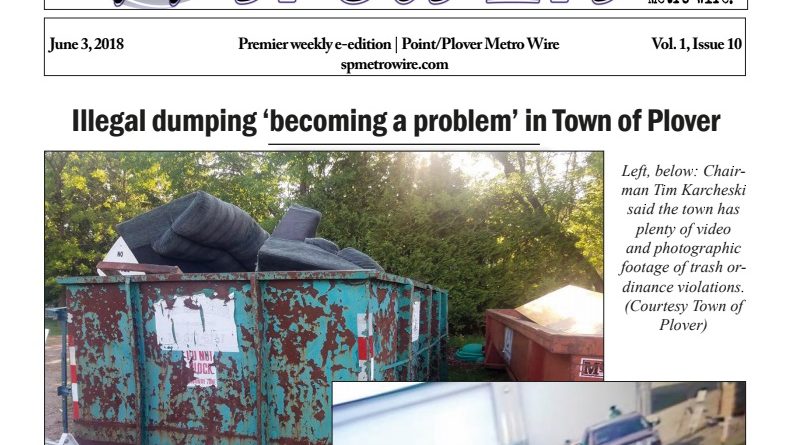Editorial: The Metro Wire’s plan for sustainability
By Brandi Makuski & Patrick Lynn
The landscape of the local news industry has changed drastically in the past few years.
Two years ago, the Stevens Point/Plover area had between eight and 10 local reporters, a mix of newbies and seasoned journalists, covering the community on a regular basis—not counting Wausau-based news directors like Mark Durham from WAOW, and Larry Lee from our friends at WSAU, who did such great work covering our community from a regional perspective before they left their roles for greener pastures.
In a series of moves that corporate managers will publicly describe with terms like “increased efficiency”, “restructuring”, and “realignment”, the number of local news reporters has been drastically reduced, either by layoffs or the popular “position elimination” play. Venture capitalists (or “vulture capitalists”, depending on who you ask) with little-to-no connection to a community buy out the interests of struggling news outlets in smaller communities. In the process, many of the checks and balances once considered vital in newsrooms for relaying fact-checked and properly-structured stories to the public are eliminated.
And they call it “progress”.
You’ve undoubtedly heard about the struggles of media outlets across the country. Even popular mastheads like the Denver Post is in trouble. The 126-year-old publication announced in March it was reducing its news staff by a third. In the same month, the Chicago Tribune also announced layoffs from its already-culled editorial staff, followed by a drastic reduction in newsroom staff (34 people lost their jobs out of 90) at the Salt Lake Tribune in May.
It’s a halcyon era for elected officials in communities losing experienced reporters. There certainly is no decrease of news, so it follows that employing fewer reporters means less news at lower quality. Many community news outlets have to forego investigative reporting and hard news coverage due to lack of staff or experience; becoming instead a compilation of regurgitated press releases. Some are becoming a mirror image to the community bulletin board at a grocery store.
But a news outlet’s function is markedly different and far more vital to the health of a community—and to democracy.
The financial struggles for community media outlets across the country are no secret, and (while each has unique circumstances) neither is the cause behind them: ad revenue for news companies has fallen drastically in recent years. With the rise of social media advertising available to small businesses, publishers have to give away a lot—and at a price that is often lower than the advertising is worth—just to stay afloat. It’s a problem affecting the entire news industry, which is why we’re seeing drastic reductions in the number of community news reporters nationwide.
Combined with rising costs for print products, publishers rush to cut expenses any way they can; eliminating staff, outsourcing services to slash overhead, raising advertising fees. Sometimes it works briefly, but cutting staff and services will never clear a path to a prosperous news outlet.
Since its inception in December of 2017, the Metro Wire has experienced tremendous growth. Local readers appear to be following quality content, and they account for some of the 142,000 visits to spmetrowire.com since April 1 alone.
Now that’s progress.
For the past six months, our staff of four—and multiple contributing writers—has been working for you free of charge (either via byline or behind the scenes). We’ve broken several stories at all hours of the day and night, and covered news you haven’t been able to find elsewhere.
But with the wide availability of free news in recent years, it’s tough to convince some that this is a service worth paying for. Regardless of quality, context, or accuracy, some folks will take the free version of a product every time.
So, while we still have a lot of work to do in finding a sustainable path forward, we do have a plan.
We could fully fund our operation if we had 3,500 people supporting us through $5 monthly digital subscriptions. That covers our salaries and benefits, laptops and pencils, and leaves room for hiring more writers to serve the community. As the Metro Wire just launched its subscription platform this week, it has nowhere to go but up, and we believe with a local audience of about 50,000, our goal is more than achievable.
We believe asking readers to pay $5 a month helps to achieve a number of our goals: it means more stories; higher accountability for reporters; ongoing professional development for our staff; a more engaged readership; providing training opportunities for aspiring journalists in our local schools; and job creation. Reaching these goals will help ensure consistency in our work, and continuity in our profession locally.
By subscribing, readers also get a chance to participate in our weekly podcasts starting in July, and each week they’ll receive our weekly printable edition, Wired In, delivered by email each Sunday. The editions are resized for easy printing from a home computer and contain all the news we reported during the week.
We aren’t hiding our entire website behind a paywall. Election results, a community calendar, and public safety issues are among the items that will remain free, and of course, we will continue to provide live-streams via Facebook as appropriate.
It’s a scary thing, placing our future in the hands of readers. But many of you have placed a great deal of faith in our staff for quite some time, and you appreciate the value of great stories. We look forward to a long presence covering Stevens Point, Plover, Park Ridge, Whiting and Hull, and we hope you take the ride with us.
You can subscribe here:
![]()
We thank you for your support!
Lynn can be reached at [email protected].

